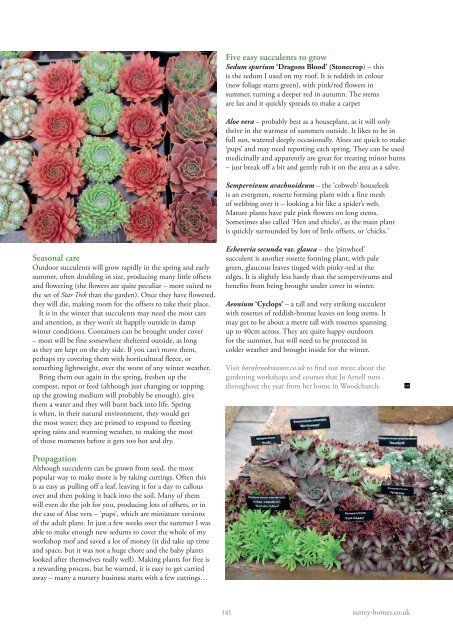Surrey Homes | SH59 | September 2019 | Education supplement inside
The lifestyle magazine for Surrey - Inspirational Interiors, Fabulous Fashion, Delicious Dishes
The lifestyle magazine for Surrey - Inspirational Interiors, Fabulous Fashion, Delicious Dishes
Create successful ePaper yourself
Turn your PDF publications into a flip-book with our unique Google optimized e-Paper software.
Five easy succulents to grow<br />
Sedum spurium ‘Dragons Blood’ (Stonecrop) – this<br />
is the sedum I used on my roof. It is reddish in colour<br />
(new foliage starts green), with pink/red flowers in<br />
summer, turning a deeper red in autumn. The stems<br />
are lax and it quickly spreads to make a carpet<br />
Aloe vera – probably best as a houseplant, as it will only<br />
thrive in the warmest of summers outside. It likes to be in<br />
full sun, watered deeply occasionally. Aloes are quick to make<br />
‘pups’ and may need repotting each spring. They can be used<br />
medicinally and apparently are great for treating minor burns<br />
– just break off a bit and gently rub it on the area as a salve.<br />
Sempervivum arachnoideum – the ‘cobweb’ houseleek<br />
is an evergreen, rosette forming plant with a fine mesh<br />
of webbing over it – looking a bit like a spider’s web.<br />
Mature plants have pale pink flowers on long stems.<br />
Sometimes also called ‘Hen and chicks’, as the main plant<br />
is quickly surrounded by lots of little offsets, or ‘chicks.’<br />
Seasonal care<br />
Outdoor succulents will grow rapidly in the spring and early<br />
summer, often doubling in size, producing many little offsets<br />
and flowering (the flowers are quite peculiar – more suited to<br />
the set of Star Trek than the garden). Once they have flowered,<br />
they will die, making room for the offsets to take their place.<br />
It is in the winter that succulents may need the most care<br />
and attention, as they won’t sit happily outside in damp<br />
winter conditions. Containers can be brought under cover<br />
– most will be fine somewhere sheltered outside, as long<br />
as they are kept on the dry side. If you can’t move them,<br />
perhaps try covering them with horticultural fleece, or<br />
something lightweight, over the worst of any winter weather.<br />
Bring them out again in the spring, freshen up the<br />
compost, repot or feed (although just changing or topping<br />
up the growing medium will probably be enough), give<br />
them a water and they will burst back into life. Spring<br />
is when, in their natural environment, they would get<br />
the most water; they are primed to respond to fleeting<br />
spring rains and warming weather, to making the most<br />
of those moments before it gets too hot and dry.<br />
Echeveria secunda var. glauca – the ‘pinwheel’<br />
succulent is another rosette forming plant, with pale<br />
green, glaucous leaves tinged with pinky-red at the<br />
edges. It is slightly less hardy than the sempervivums and<br />
benefits from being brought under cover in winter.<br />
Aeonium ‘Cyclops’ – a tall and very striking succulent<br />
with rosettes of reddish-bronze leaves on long stems. It<br />
may get to be about a metre tall with rosettes spanning<br />
up to 40cm across. They are quite happy outdoors<br />
for the summer, but will need to be protected in<br />
colder weather and brought <strong>inside</strong> for the winter.<br />
Visit hornbrookmanor.co.uk to find out more about the<br />
gardening workshops and courses that Jo Arnell runs<br />
throughout the year from her home in Woodchurch.<br />
Propagation<br />
Although succulents can be grown from seed, the most<br />
popular way to make more is by taking cuttings. Often this<br />
is as easy as pulling off a leaf, leaving it for a day to callous<br />
over and then poking it back into the soil. Many of them<br />
will even do the job for you, producing lots of offsets, or in<br />
the case of Aloe vera – ’pups’, which are miniature versions<br />
of the adult plant. In just a few weeks over the summer I was<br />
able to make enough new sedums to cover the whole of my<br />
workshop roof and saved a lot of money (it did take up time<br />
and space, but it was not a huge chore and the baby plants<br />
looked after themselves really well). Making plants for free is<br />
a rewarding process, but be warned, it is easy to get carried<br />
away – many a nursery business starts with a few cuttings…<br />
141 surrey-homes.co.uk


















